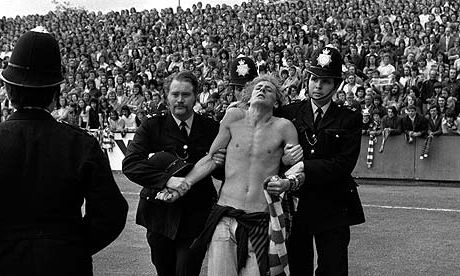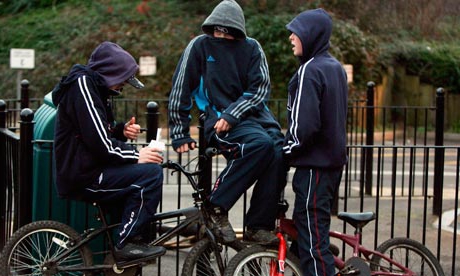Hooliganism has long ceased to be just an asocial phenomenon and moved to the section administrative misconduct or even criminally punishable. But not everyone knows what exactly lies behind such a seemingly frivolous article.
What is hooliganism?

The exact time of origin of the term is unknown, but for the first time in the reports of the London police, he began to appear in the late 19th century. One version tells that this is the name of an Irish thief and a bouncer (Patrick Hooligen), which has become a household name since the time.
In pre-revolutionary Russia, the term "hooligan" was positioned as a person engaged in bullying of citizens, an ordinary street loafer. Much later, the concept acquired mass character. Hooliganism has become a kind of subculture and has become rampant. The groups had their own “Code of Honor”, hierarchy, and uniform. A criminal article for hooliganism was first introduced in 1922. It was defined as mischievous, aimless, and also associated with a clear manifestation of disrespect for the surrounding citizens or society as a whole.
Article for Hooliganism: Criminal Code
Now, crimes directed against public safety are understood to mean reckless or intentional dangerous acts, which include chapter 24 of the Criminal Code of the Russian Federation. They cause or pose a very real threat of causing significant harm to the vital interests of the individual, society and the state as a whole. The article of the Criminal Code for Hooliganism (Article 213) also applies to them. She establishes that any violation of order in a public place in a rude form, coupled with a clear disrespect for society, is recognized as such.

Types of Hooliganism
The article for hooliganism in the Criminal Code of the Russian Federation establishes not only the sanctions applied to violators, but also delimits the types of this crime. In total, there are three of them:
- domestic hooliganism, it is committed with weapons or items used in its place;
- extremist, there are no signs characteristic of the first kind, but there is a significant motive (ideological, national, racial, religious hatred or enmity);
- mixed, it is the most dangerous; in addition to a serious motive, the active use of weapons and their substitute items is involved.
Hooliganism
Generic object of all types of crimes considered in the aforementioned chapter of the Criminal Code, are public relations. They are designed to ensure public safety, environmental, protect the health of citizens, etc. But both in theory and in practice, the argument does not subside. The opinion is expressed that any crime to a certain extent affects both public order and the interests of an individual or group of persons. Therefore, the object of this crime must also depend on whose rights are most affected. The question is still open and needs to be improved.
Objective side
It is the same for all three types of criminal acts, which includes an article for hooliganism (213 of the Criminal Code of the Russian Federation). The objective side is characterized by an act assuming a dangerous nature. It represents a gross violation of order and is expressed in open disrespect for society. All this manifests itself in a gross violation of the rules of conduct and generally recognized norms, which is dictated by the desire to oppose others and demonstrate the full degree of neglect of them.The situation in which the crime was committed (must be public) and the method (using weapons or any objects instead) are mandatory signs of the objective side.
If in a criminal act there was a use of animals that are dangerous to a person, his life and health, then taking into account the specific circumstances for qualification, an article for hooliganism in part 1 of paragraph “a” can be taken. When using a faulty, unloaded, unusable weapon or a souvenir, decorative or toy, the actions also fall under paragraph “a” of the first part of Art. 213 of the Criminal Code.
An offense is recognized as completed at the moment when gross and openly violating public order are committed.
Who is the subject of hooliganism?

The Criminal Code article for hooliganism provides for a common subject. According to articles 19-20 of the said law, any sane individual who has reached the age of 16 by the time he commits a crime will be liable. In the presence of aggravating circumstances, the age threshold is reduced to 14 years. These may be:
- participation in a preliminary conspiracy as part of a group (regular or organized);
- resistance to representatives of authorities or other persons whose duties are directly related to maintaining public order.
Signs of the subjective side
For the everyday kind of hooliganism, a special motive is that a person openly and defiantly expresses a challenge to others, seeks to contrast his own interests of society, to show his dismissive attitude, permissiveness and cruelty. Moreover, the act can be committed both in the presence of an insignificant reason, and in its absence. For example, the wrong (in the personal opinion of the bully) look of the victim, an accidental push, etc.
In the process of qualification, an article for hooliganism should have a clear distinction from other actions similar in content. For example, those committed on the basis of a personal hostile attitude that arose from the guilty party to the victim. Such a crime should be qualified as directed against the individual. But at the same time, if a quarrel arising out of hostility develops into a violation of public order and security, then actions must be qualified as hooligan.
Hooliganism Article: Punishment

Even despite the increasing legal literacy of the population, many teenagers are not aware that some of their actions may well fall under the sanctions of the criminal law. It would seem that the not-so-serious word “hooliganism” is punished with rather severe fines and even imprisonment. In the case of a simple corpus delicti, even for serious religious or national reasons, the sanctions framework is the same. They provide for:
- a fine in the amount of 300 to 500 thousand rubles, or in an amount similar to wages or other income for a period of two to three years;
- or up to 480 hours of compulsory work;
- or corrective labor for up to two years, but not less than one year;
- or imprisonment or forced labor for up to five years.
With qualified staff, the punishment naturally increases. A fine of up to a maximum amount of 1 million rubles, and imprisonment (or forced labor) - up to 7 years.
Petty hooliganism
Article for petty hooliganism provided for by the Administrative Code of the Russian Federation. Its content is similar to that in the Criminal Code, but differs in less danger and milder sanctions. So, according to her, hooliganism is nothing more than a violation of order in a public place, expressed in obvious disrespect for others, which may be accompanied by obscene language and abuse, harassment, offensive to citizens, as well as damage or destruction of other people's property.
A qualifying sign is disobedience to a representative of the authorities, disobedience to his lawful requirement or another person who exercises control over public order.
The sanction of the article contains the following types of punishment:
- administrative fine, in the first case in the amount of from 500 rubles to one thousand, and in the second - from 1000 to 2000;
- administrative arrest up to two days.
Authorities authorized to monitor order
This category of persons should include military personnel, persons engaged in private security or detective activities, involved in the protection of public safety and order, officials of local governments.
Telephone bullies: how to punish?

Unfortunately, the article for telephone hooliganism is not provided by either the Criminal Code or the Administrative Code of the Russian Federation. Often, police officers simply refuse to accept a statement from citizens who have suffered from the actions of unknown persons, who periodically with persistence make phone calls to them, send offensive messages, etc. Very often you can hear only one piece of advice - change the number. In fact, such actions do not contain signs of the composition provided for in Art. 213 of the Criminal Code and 20.1 Administrative Code of the Russian Federation. But upon receipt of threats, blackmail or extortion, qualification of actions under other articles of the criminal law is possible. Especially if there is a recording from the recorder, sms.
Hooliganism Prevention
Prevention of hooliganism can be defined as a targeted and systematic effect on people leading an asocial lifestyle, disrupting public order and expressing open disrespect to everyone around them. It has its own characteristics. It is believed that the multi-level system for the prevention of hooliganism is most effective.
Depending on the objectives, it is customary to distinguish several of its types. For example, general prevention, in its framework, a generally preventive effect on people is carried out in order to prevent antisocial actions on their part. It can be criminal law or procedural (gives an explanation of which article for hooliganism is provided for in the Criminal Code, what sanctions are, etc.), criminological, etc. Also moral, psychological, pedagogical, medical and other types deserve attention.
Today, social prevention has long gone beyond the scope of exclusively lawyers and takes on other features. It extends its effect to all spheres of life, involving teachers, psychologists, narcologists and other specialists from various branches of knowledge in the active participation. It seems very useful to expand the network of funds, crisis centers, institutions of socio-psychological assistance.

As for the most vulnerable and at-risk group - children and adolescents, family and leisure issues should come to the fore. Man is a social being. The more time a child will be busy in various circles, sports sections, the less time he will have to stroll through the streets and idleness. Of course, do not forget about dysfunctional families. Timely identification of problems will help the child not get to the criminal article.









